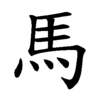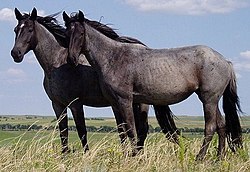馬
Translingual
| Stroke order | |||
|---|---|---|---|

| |||
| Stroke order (Hong Kong) | |||
|---|---|---|---|

| |||
Han character
馬 (Kangxi radical 187, 馬+0, 10 strokes, cangjie input 尸手尸火 (SQSF), four-corner 71327, composition ⿹⿺㇉⿻三丨灬)
- Kangxi radical #187, ⾺.
Derived characters
- Index:Chinese radical/馬
- 傌(㐷), 馮(冯), 嗎(吗), 媽(妈), 榪(杩), 瑪(玛), 溤, 獁(犸), 碼(码), 禡(祃), 螞(蚂), 鎷(𨰾), 䣕, 遤, 㾺(𬏜), 罵/駡(骂), 闖(闯), 褭(𬡇)
Related characters
References
- Kangxi Dictionary: page 1433, character 1
- Dai Kanwa Jiten: character 44572
- Dae Jaweon: page 1956, character 34
- Hanyu Da Zidian (first edition): volume 7, page 4539, character 1
- Unihan data for U+99AC
Chinese
Glyph origin
| Historical forms of the character 馬 | |||||||||||
|---|---|---|---|---|---|---|---|---|---|---|---|
| Shang | Western Zhou | Spring and Autumn | Warring States | Shuowen Jiezi (compiled in Han) | Liushutong (compiled in Ming) | Libian (compiled in Qing) | |||||
| Bronze inscriptions | Oracle bone script | Bronze inscriptions | Bronze inscriptions | Bronze inscriptions | Chu slip and silk script | Qin slip script | Shizhoupian script | Ancient script | Small seal script | Transcribed ancient scripts | Clerical script |

|

|

|

|

|

|

|

|

|

|

|

|
| Semi-cursive script | Cursive script |
|---|---|

|

|
Pictogram (象形) – a horse with its head facing the left, showing a flowing mane in the wind. In the bronze inscriptions, the head was often simplified into an eye (目). The legs eventually evolved into four dots (灬, unrelated to 火).
Contrast with 鹿 (“deer”), which saw a very different development, and 𢊁 (as in 薦), which is a hybrid: it has the legs of 馬 (灬) but the head of 鹿.
Etymology
| trad. | 馬 | |
|---|---|---|
| simp. | 马 | |
| alternative forms | ||
“Horse” – from Proto-Sino-Tibetan *k-m-raŋ ~ s-raŋ. The sense of “big” is derived from “horse”; compare the English uses of horse.
For the insect prefix sense, see 螞. It has converged with the sense of “big”.
The surname is popularly known to be prevalent among Hui Muslims, where it is likely derived from Arabic مُحَمَّد (muḥammad, “Muhammad”).
Pronunciation
Lua error in Module:wuu-pron at line 162: Incorrect tone notation "3" for sh. See WT:AZH/Wu.
Definitions
- horse (Classifier: 匹 m; 隻/只 m c)
- horse-shaped
- (chess) knight
- (xiangqi) knight; horse (on the black side)
- Original form of 碼/码 (mǎ, “chip for counting”).
- big (prefix for nouns)
- (Southwestern Mandarin, including Sichuanese) to bully
- (Sichuanese) to keep a straight face
- Prefix for names of insects, also written as 螞.
- Short for 馬祖/马祖 (Mǎzǔ).
- Short for 馬來西亞/马来西亚 (Mǎláixīyà).
- a surname
- 馬英九/马英九 ― Mǎ Yīngjiǔ ― Ma Ying-jeou (President of the Republic of China (Taiwan), 2008-2016)
- (~村) Ma (a village in Dongsong, Luoning, Luoyang, Henan, China)
Synonyms
Coordinate terms
- (Chinese chess pieces) 帥/帅 (shuài) / 將/将, 仕 (shì) / 士 (shì), 相 / 象 (xiàng), 俥/伡 / 車/车, 傌 / 㐷 / 馬/马 (mǎ), 炮 / 砲/炮, 兵 (bīng) / 卒
Compounds
Lua error in Module:zh/templates at line 32: This template has been deprecated. Please use Template:col3 instead.
Descendants
Others:
- Lua error in Module:etymology/templates/descendant at line 287: You specified a term in 4= and not one in 3=. You probably meant to use t= to specify a gloss instead. If you intended to specify two terms, put the second term in 3=.
- Lua error in Module:etymology/templates/descendant at line 287: You specified a term in 4= and not one in 3=. You probably meant to use t= to specify a gloss instead. If you intended to specify two terms, put the second term in 3=.
- Lua error in Module:etymology/templates/descendant at line 287: You specified a term in 4= and not one in 3=. You probably meant to use t= to specify a gloss instead. If you intended to specify two terms, put the second term in 3=.
- Lü: ᦙᦱᧉ (maa²)
- Lua error in Module:etymology/templates/descendant at line 287: You specified a term in 4= and not one in 3=. You probably meant to use t= to specify a gloss instead. If you intended to specify two terms, put the second term in 3=.
- Lua error in Module:etymology/templates/descendant at line 287: You specified a term in 4= and not one in 3=. You probably meant to use t= to specify a gloss instead. If you intended to specify two terms, put the second term in 3=.
- Lua error in Module:etymology/templates/descendant at line 287: You specified a term in 4= and not one in 3=. You probably meant to use t= to specify a gloss instead. If you intended to specify two terms, put the second term in 3=.
- Lua error in Module:etymology/templates/descendant at line 287: You specified a term in 4= and not one in 3=. You probably meant to use t= to specify a gloss instead. If you intended to specify two terms, put the second term in 3=. (via Teochew)
References
- “Entry #6822”, in 臺灣閩南語常用詞辭典 [Dictionary of Frequently-Used Taiwan Minnan] (overall work in Mandarin and Hokkien), Ministry of Education, R.O.C., 2023.
Japanese
Kanji
| Stroke order (Japan) | |||
|---|---|---|---|

| |||
Readings
Compounds
- 牛馬 (ushiuma): a small breed of horse, extinct since 1947
- 海馬 (umiuma): seahorse
- 牛馬 (gyūba): oxen and horses, beast of burden
- 海馬 (kaiba): seahorse; walrus; hippocampus
- 河馬 (kaba): hippopotamus, a hippo
- 縞馬 (shimauma), 斑馬 (shimauma): zebra
- 騸馬 (senba): gelding
- 馬酔木 (asebi), 馬酔木 (basuiboku): Japanese andromeda
- 馬面 (umazura): a horseface, a very long face; horse-faced, very long-faced
- 馬鹿 (baka): a fool, an idiot; foolish, idiotic, stupid
- 馬鹿力 (bakajikara): incredible strength; incredibly strong
- 馬脚 (bakyaku)
- 馬具 (bagu): horse harness, horse tack
- 馬券 (baken)
- 馬耳東風 (baji tōfū)
- 馬車 (basha): horse-drawn carriage, wagon or cart
- 馬糧 (baryō): horse feed
- 馬車馬 (bashauma)
- 馬術 (bajutsu): equestrianism, equestrian skills, horsemanship
- 馬上 (bajō): on horseback
- 馬尾 (babi): cauda equina
- 馬力 (bariki): horsepower
- 馬鈴薯 (bareisho): a potato (Solanum tuberosum)
- 馬簾 (baren)
- 子馬 (kōma): a baby horse, a foal
- 馬子 (mago): packhorse driver
- 馬手 (bashu), 馬手 (mete)
- 木馬 (mokuba): a wooden horse
- 馬陸 (yasude): millipede
- 騾馬 (raba): mule
- 驢馬 (roba): donkey
- 競馬 (keiba): a horse race
- 弓馬 (kyūba): archery and horsemanship
Etymology 1

| Kanji in this term |
|---|
| 馬 |
| うま Grade: 2 |
| kun'yomi |
From Old Japanese.[1] Recorded in the Nihon Shoki as having been brought over from the Korean peninsula kingdom of Baekje, with the earlier reading of ma. The initial m sound was apparently emphasized,[1][2] possibly similar to *mma, becoming then uma or muma, via processes also seen in the word 梅 (ume, mume, “plum”).
The ma sound denoting "horse" is common to a number of languages of central Asia, where horses were first domesticated, suggesting a possible cognate root. Compare Manchu ᠮᠣᡵᡳᠨ (morin, “horse”), Mongolian морь (morʹ, “horse”), Korean 말 (mal, “horse”), Mandarin 馬/马 (mǎ, “horse”), and Proto-Indo-European *márkos (“horse”) and descendants such as Irish marc (“horse”, archaic) or English mare (“female horse”). More at *márkos.
Pronunciation
Lua error in Module:ja-pron at line 89: Parameter "yomi" is not used by this template.
Noun
- a horse
- (shogi) a promoted bishop
- a sawhorse: a four-leg stand made of wood or iron for supporting other materials
Etymology 2
| Kanji in this term |
|---|
| 馬 |
| むま Grade: 2 |
| kun'yomi |
Shift from uma form, becoming more common starting from the Heian Period. This change later reverted, and muma is now considered obsolete.
Pronunciation
Lua error in Module:ja-pron at line 89: Parameter "yomi" is not used by this template.
Noun
- (obsolete) a horse
-
- 阿志加良能 美佐可多麻波理 可閇理美須 阿例波久江由久 阿良志乎母 多志夜波婆可流 不破乃世伎 久江弖和波由久 牟麻能都米 都久志能佐伎尓 知麻利為弖 阿例波伊波々牟 母呂々々波 佐祁久等麻乎須 可閇利久麻弖尓
- c. 935 Tosa Nikki
- ふぢはらのときざね、ふなぢなれど、むまのはなむけす。
- c. 935 Tosa Nikki
- けふはあをむまをおもへど、かひなし。
-
Etymology 3
| Kanji in this term |
|---|
| 馬 |
| ば Grade: 2 |
| kan'on |
From Middle Chinese 馬 (MC maeX).
Pronunciation
Lua error in Module:ja-pron at line 89: Parameter "y" is not used by this template.
Affix
References
Korean
Hanja
馬 (eumhun 말 마 (mal ma))
馬 (eumhun 성 마 (seong ma))
- horse (in compounds)
Compounds
See also
- 말 (mal)
Vietnamese
Han character
馬: Hán Việt readings: mã (
馬: Nôm readings: mựa[1][2][6][4][5][7], mã[1][2][4][5][7], mở[1][2][3], mứa[6][5][7], mả[1][2], mỡ[1], ngựa[2]
Etymology 1
From Middle Chinese 馬 (MC maeX, “horse”).
Noun
Derived terms
Etymology 2
Adjective
Etymology 3
Verb
Etymology 4
Noun
- Nôm form of mả (“tomb; grave”).
- 1916, Nguyễn Đình Chiểu, Lục Vân Tiên (蓼雲僊) [Tale of Lục Vân Tiên], lines 921–922:
小 童 庄 及 哙 㗍 𦣰 陵 边 馬 哭 嘆 徘 徊 - Before the page has a chance to pay a visit,
He throws himself down upon the grave, crying, lamenting, fretting.
- Before the page has a chance to pay a visit,
Etymology 5
Verb
Etymology 6
Noun
References
- Han character radicals
- Translingual lemmas
- Translingual symbols
- Han script characters
- Han pictograms
- Chinese terms inherited from Proto-Sino-Tibetan
- Chinese terms derived from Proto-Sino-Tibetan
- Chinese terms derived from Arabic
- Chinese lemmas
- Chinese hanzi
- Chinese nouns classified by 匹
- Chinese nouns classified by 隻/只
- zh:Chess
- zh:Xiangqi
- Mandarin terms with usage examples
- Southwestern Mandarin
- Sichuanese Chinese
- Chinese short forms
- Chinese surnames
- zh:Villages in Henan
- zh:Villages in China
- zh:Places in Henan
- zh:Places in China
- Beginning Mandarin
- zh:Horses
- zh:Mammals
- Japanese kanji
- Japanese second grade kanji
- Japanese kyōiku kanji
- Japanese jōyō kanji
- Japanese kanji with goon reading め
- Japanese kanji with kan'on reading ば
- Japanese kanji with kan'yōon reading ま
- Japanese kanji with kun reading うま
- Japanese kanji with kun reading ま
- Japanese terms spelled with 馬 read as うま
- Japanese terms read with kun'yomi
- Japanese terms inherited from Old Japanese
- Japanese terms derived from Old Japanese
- Japanese lemmas
- Japanese nouns
- Japanese terms with multiple readings
- Japanese terms spelled with second grade kanji
- Japanese terms with 1 kanji
- Japanese terms spelled with 馬
- Japanese single-kanji terms
- ja:Shogi
- Japanese terms spelled with 馬 read as むま
- Japanese terms with obsolete senses
- Japanese terms spelled with 馬 read as ば
- Japanese terms read with kan'on
- Japanese terms derived from Middle Chinese
- Japanese affixes
- Japanese basic words
- ja:Horses
- Korean lemmas
- Korean hanja
- Vietnamese Chữ Hán
- Vietnamese lemmas
- Vietnamese Han characters
- Vietnamese Nom
- Vietnamese terms derived from Middle Chinese
- Vietnamese nouns
- Vietnamese nouns in Han script
- vi:Xiangqi
- Vietnamese adjectives
- Vietnamese adjectives in Han script
- Vietnamese verbs
- Vietnamese verbs in Han script
- Vietnamese dialectal terms
- Vietnamese terms with quotations
- CJKV radicals


